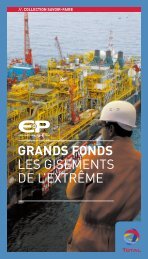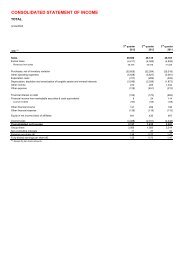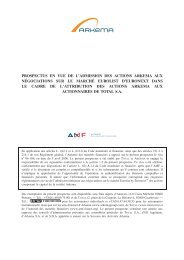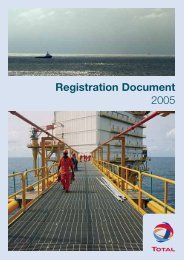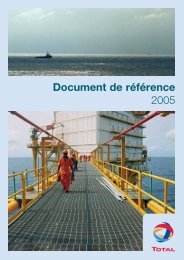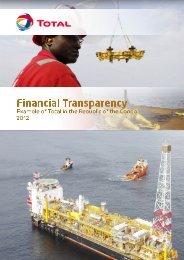Registration document 2007 - Total.com
Registration document 2007 - Total.com
Registration document 2007 - Total.com
You also want an ePaper? Increase the reach of your titles
YUMPU automatically turns print PDFs into web optimized ePapers that Google loves.
Risk management<br />
Risk evaluations lead to the establishment of management<br />
measures that are designed to prevent and decrease the<br />
environmental impacts, to minimize the risks of accidents and to<br />
limit their consequences. These measures may be put into place<br />
through equipment design itself, reinforcing safety devices,<br />
designs of structures to be built and protections against the<br />
consequences of environmental risks. Risk evaluations may be<br />
ac<strong>com</strong>panied, on a case by case basis, by an evaluation of the<br />
cost of risk control and impact reduction measures.<br />
TOTAL is working to minimize industrial and environmental risks<br />
inherent to its activities by putting in place performance<br />
procedures and quality, safety and environmental management<br />
systems, as well as by moving towards obtaining certification for<br />
or assessment of its management systems (including<br />
International Safety Rating System, ISO 14001, European<br />
Management and Audit Scheme), by performing strict<br />
inspections and audits, training staff and heightening awareness<br />
of all the parties involved, and by an active investment policy.<br />
More specifically, following up on the 2002-2005 plan, an action<br />
plan was defined for the 2006-2009 period. This plan is focused<br />
on two initiatives for improvement: reducing the frequency and<br />
seriousness of on-the-job accidents and managing industrial<br />
risks. The results related to reducing on-the-job accidents are in<br />
line with goals, with a significant decrease in the rate of accidents<br />
(with or without time-lost) per million hours worked by nearly 70%<br />
between the end of 2001 and the end of 2006. In terms of<br />
industrial risks, this plan’s initiatives include specific organization<br />
and behavioral plans as well as plans to minimize risks and<br />
increase safety for people and equipment.<br />
Several environmental action plans have been put in place in<br />
different activities of the Group covering periods up until 2012.<br />
These plans are designed to improve environmental performance,<br />
particularly regarding the use of natural resources, air and water<br />
pollution, waste production and treatment, and site<br />
decontamination. They also contain quantified objectives to<br />
reduce greenhouse gas emissions, water pollution and sulphur<br />
dioxide emissions and to improve energy efficiency. As part of its<br />
efforts to reduce greenhouse gases and <strong>com</strong>bat climate change,<br />
in December 2006 the Group <strong>com</strong>mitted to reducing gas flaring<br />
at its Exploration & Production sites by 50% <strong>com</strong>pared to 2005<br />
volumes by 2012. The Group also expects that 75% of its major<br />
sites will receive ISO 14001 certification by <strong>2007</strong>. These activities<br />
are monitored through periodic, coordinated reporting by all<br />
Group entities.<br />
More detailed information on TOTAL’s actions regarding safety<br />
and environmental concerns is provided in the separate report<br />
entitled Sharing Our Energies published by the Group.<br />
Although the Group believes that, according to its current<br />
estimates, contingencies or liabilities related to health, safety and<br />
environmental concerns would not have a material impact on its<br />
consolidated financial situation, its cash flow or its in<strong>com</strong>e, due<br />
to the nature of such concerns it is impossible to predict if in the<br />
future these types of <strong>com</strong>mitments or liabilities could have a<br />
material adverse effect on the Group’s activities.<br />
Asbestos<br />
Risk Factors<br />
Industrial and environmental risks<br />
4<br />
Like many other industrial groups, TOTAL is involved in claims<br />
related to occupational diseases caused by asbestos exposure.<br />
The circumstances described in these claims generally concern<br />
activities prior to the beginning of the 1980s, long before the<br />
<strong>com</strong>plete ban on the use of asbestos in most of the countries<br />
where the Group operates (January 1, 1997 in France). The<br />
Group’s various activities are not particularly likely to lead to<br />
significant exposure to asbestos related risks, since this material<br />
was generally not used in manufacturing processes, except in<br />
limited cases. The main potential sources of exposure are related<br />
to the use of certain insulating <strong>com</strong>ponents in industrial<br />
equipment. These <strong>com</strong>ponents are being gradually eliminated<br />
from the Group’s equipment through asbestos-elimination plans<br />
that have been underway for several years. However, considering<br />
the long period of time that may elapse before the harmful results<br />
of exposure to asbestos manifest themselves (up to 40 years),<br />
we anticipate that claims may be filed in the years to <strong>com</strong>e.<br />
Asbestos related issues have been subject to close monitoring in<br />
all branches of the Group. As of December 31, 2006, the Group<br />
estimates that the ultimate cost of all asbestos related claims<br />
paid or pending is not likely to have a material adverse effect on<br />
the financial situation of the Group.<br />
TOTAL – <strong>Registration</strong> Document 2006 85




